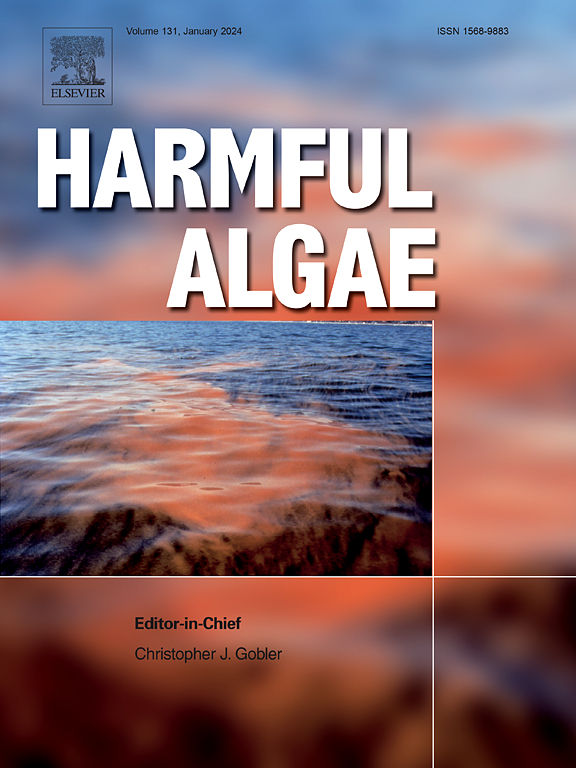Temporal bloom dynamics of the marine dinoflagellate Tripos furca in the Penang Strait
IF 4.5
1区 生物学
Q1 MARINE & FRESHWATER BIOLOGY
引用次数: 0
Abstract
The dinoflagellate Tripos furca, known for its frequent and massive blooms in coastal waters, has been associated with significant fish mortality in aquaculture areas. In mid-May 2022, a notable bloom event, characterized by intense red discoloration, was observed along the Penang Strait in the northern Malacca Strait. Our field survey identified a high-density bloom of T. furca. To investigate the mechanisms driving the bloom dynamics of this species, monthly sampling was undertaken until the bloom subsided, covering 19 stations across the Penang Strait. Our results showed that the abundances of T. furca changed over time and space, a bloom peak of 8.2 × 105 cells l-1 was observed in late June, triggered by elevated sea surface temperatures and phosphate availability, while nitrogen was consistently abundant. The bloom's persistence was associated with the influence of the 2020–2022 La Niña and Indian Ocean Dipole, which caused warmer sea temperatures. Metabarcoding of the V7-V9 18S rDNA region revealed high intraspecific genetic diversity within the T. furca bloom subpopulations, suggesting both clonal reproduction and possible sexual processes. The bloom termination was linked to a seasonal shift in temperatures and changes in nutrient regimes that caused a transition of phytoplankton compositions to Noctiluca- and diatom-dominated populations contributed to the bloom's decline. Early detection of the bloom has successfully prevented severe losses to the aquaculture farms in the area, emphasizing the importance of early intervention. This study also enhances our understanding of T. furca bloom dynamics and provides insights into managing harmful algal blooms in tropical coastal regions.

槟城海峡海洋鞭藻三角藻的时间水华动态
以在沿海水域频繁大规模繁殖而闻名的三角鞭毛藻(Tripos furca)与水产养殖区大量鱼类死亡有关。2022年5月中旬,在马六甲海峡北部的槟城海峡观察到一次显著的水华事件,其特征是强烈的红色变色。我们的实地调查发现了高密度的furca菌潮。为了研究该物种的水华动态机制,我们每月进行一次采样,直到水华消退,覆盖了槟城海峡的19个站点。结果表明,furca的丰度随时间和空间的变化而变化,6月下旬出现了8.2 × 105 cells l-1的水华高峰,这是由海水表面温度升高和磷酸盐有效性引起的,而氮则持续丰富。藻华的持续存在与2020-2022年La Niña和印度洋偶极子的影响有关,这导致海洋温度升高。对V7-V9 18S rDNA区域的元条形码分析显示,T. furca bloom亚群具有较高的种内遗传多样性,可能存在无性繁殖和有性繁殖。水华的终止与温度的季节性变化和营养状况的变化有关,这些变化导致浮游植物组成向夜光藻和硅藻为主的种群过渡,导致了水华的减少。早期发现藻华成功地防止了该地区水产养殖场的严重损失,强调了早期干预的重要性。该研究还提高了我们对furca藻华动态的理解,并为热带沿海地区有害藻华的管理提供了见解。
本文章由计算机程序翻译,如有差异,请以英文原文为准。
求助全文
约1分钟内获得全文
求助全文
来源期刊

Harmful Algae
生物-海洋与淡水生物学
CiteScore
12.50
自引率
15.20%
发文量
122
审稿时长
7.5 months
期刊介绍:
This journal provides a forum to promote knowledge of harmful microalgae and macroalgae, including cyanobacteria, as well as monitoring, management and control of these organisms.
 求助内容:
求助内容: 应助结果提醒方式:
应助结果提醒方式:


